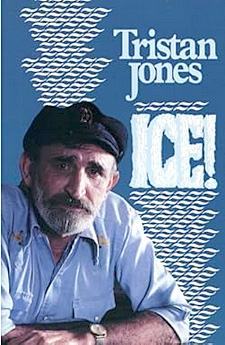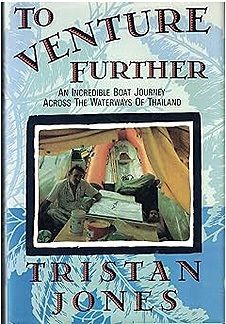If you love boating and sailing and want some sea adventures to keep you in a nautical frame of mind, I recommend you delve into the 16 books written by Tristan Jones over the course of his lifetime at sea.
These books are exciting, full of excellent tips on nautical skills, and filled with both humor and mystery. You can actually call his books “Published Paradoxes.” His publisher is Sheridan House and they continue to sell well after he wrote his first “The Incredible Journey.”
Almost half a century ago.

Tristan Jones was the pen name of one “Arthur Jones,” conceived and born by his mother in 1924 on his father’s tramp steamer delivering freight around the British Isles and he was born off Tristan Da Cunha in the faraway South Atlantic, which supplied his first name. Actually, Tristan was born in 1929 and spent his youth in orphanages, which were sorry ass places in Britain. Nothing had changed about them since Dickens wrote Oliver Twist almost a century before (“Please Sir, can I have some more?”). He never had a formal education of any kind, which makes his ability to write about his adventures more incredible than “The Incredible Journey.”
In his book “A Steady Trade,” he describes how he began working on sailing sloops and trade barges, which were prevalent as means of moving goods, food stuffs, and products around Britain to Wales, Ireland, Scotland, the Channel and northern islands. It was hard work, and it really did teach him the tools of the trade, from tying knots, keeping watch, heaving heavy goods and actually piloting these crafts at an early age. These early years were Tristan’s classroom and much of the knowledge of those early days he weaved into his writing in addition to adding a bit of his imagination to every adventure written about.
In his book “Heart of Oak’’ he tells of his World War II adventures in the Royal Navy. His details of life on board destroyers defending the world from Hitler’s “Wolf Pack” submarines are exacting and his accounts of being on three different torpedoed destroyers and being saved from the icy North Atlantic stir the imagination and it was Tristan’s imagination that puts you right in the center of the action. The only issue is that Tristan didn’t join the Royal Navy until one year after the war ended in 1946. That was pure Tristan.
He broke many sailing records in his time on predominantly small sailing vessels, which he outfitted so that he could sail them single-handedly. Many of his years were spent on Creswell. In some of his works, he has his own sketches and photos of how he made small boat interiors fit everything needed for comfort and safety. How he set up his alcohol stove, his berth, a writing desk, lanterns, food and clothing storage, charts, and his valued collection of books. Then there was his extra anchor, line, foul-weather gear, toolbox – you name it, Tristan had a place for it. You can learn tons just by seeing how he had a safe place for everything, even his beloved rum.

Tristan was the first to sail the full extent of the Atlantic by the longitude from the navigable waters of the South Pole to as far as the North Pole, as his ship, Creswell, would take him. He outlined this in his book “Ice.” He was credited with this by The Explorers Club, who has its home in NY City. The claim that he was icebound for 366 days may be another one of Tristan’s “Gilding the Lily,” but only his imagination knows what is real or not. He also alleged he hauled his boat over the Andes mountains to the Paraguay river and then through the Mato Grosso to Argentina. His description of flora and fauna, tribes he encountered and the stressful trials he encountered are hard to challenge even today. As with all things Tristan, there was a lot of truth in what he wrote, but he was an adventurous embellisher, which makes his books so readable and exciting.
He spent a few years in Greenwich Village, New York, where he holed up in an apartment writing three of his books. He was comfortable amongst the many artists, folk singers, and writers in the area and the bars he hung out in. I actually saw the Creswell tied up in the South Street Seaport in the 1970’s tied up between the sailing ship Peking and Pete Seeger’s sloop Clearwater, when we attended one of Pete’s concerts to clean up the Harbor and the Hudson River. Good guy, Pete. My own father sang with him on the Clearwater back in the day.
Eventually, that little boat would be hoisted and sawed in half to get it into a ballroom at the Waldorf Astoria, where Tristan gave a lecture and received an award from the Explorers Club. That was the dignified end to Creswell, but Tristan would go on to other vessels, most were larger than Creswell and on some, he had other sailors crew with him. During this time, he wrote four more books: Saga of a Wayward Sailor, Dutch Treat, Adrift, and Aku. He became fully recognized by buffs when he wrote his opus, the 1982 “One Hand for the Ship and One for Yourself – The Essentials of Single-Handed Sailing”. In this book, there is none of Tristan’s fact-twisting. This book is straightforward and all facts, a masterpiece that is still used as one of the guidebooks for single-handed sailing today.
In his later years, Tristan faced many physical challenges. First, he had one leg amputated due to accidents over the years. He then refit a boat to suit his impairment and then continued his sailing life as told in his “Outward Leg.” He went on to live in Thailand, where he taught poor children to sail as he continued writing. During this period, he gave up his Christian faith and became a Muslim, taking the name “Ali,” but most continued to call him Tristan and he was okay with that. In 1991, his other leg was amputated and although he refitted his vessel to accommodate this latest setback and try to continue sailing, his state of mind, normally being upbeat and able to handle anything, began to suffer and a stroke finally overtook him in 1995. He donated all future royalties from his still well-selling books to orphanages and charities that help children.
Who Tristan really was, where he sailed, what his reality was, does not matter. What matters is that he was an orphaned boy with nothing of his own in this world, who learned how to sail, took many chances, taught himself to write fantastic accounts of his adventures, misadventures and some made-up adventures and got them published in 16 books that included a wealth of nautical knowledge. I highly recommend you keep your mind at sea by reading his adventures this winter.
Copyright 2025 by Mark C. Nuccio
All rights reserved.
All comments and tirades can be sent to “mark@designedge.net
